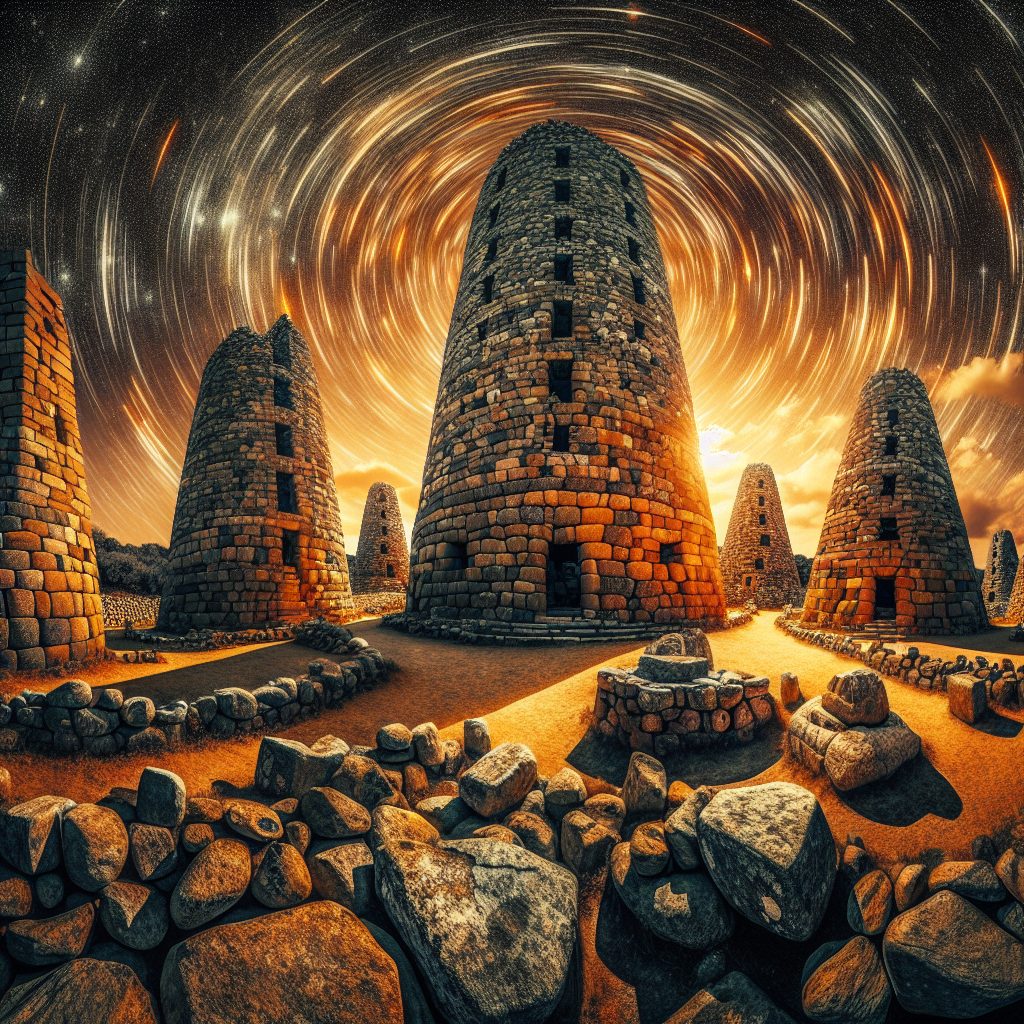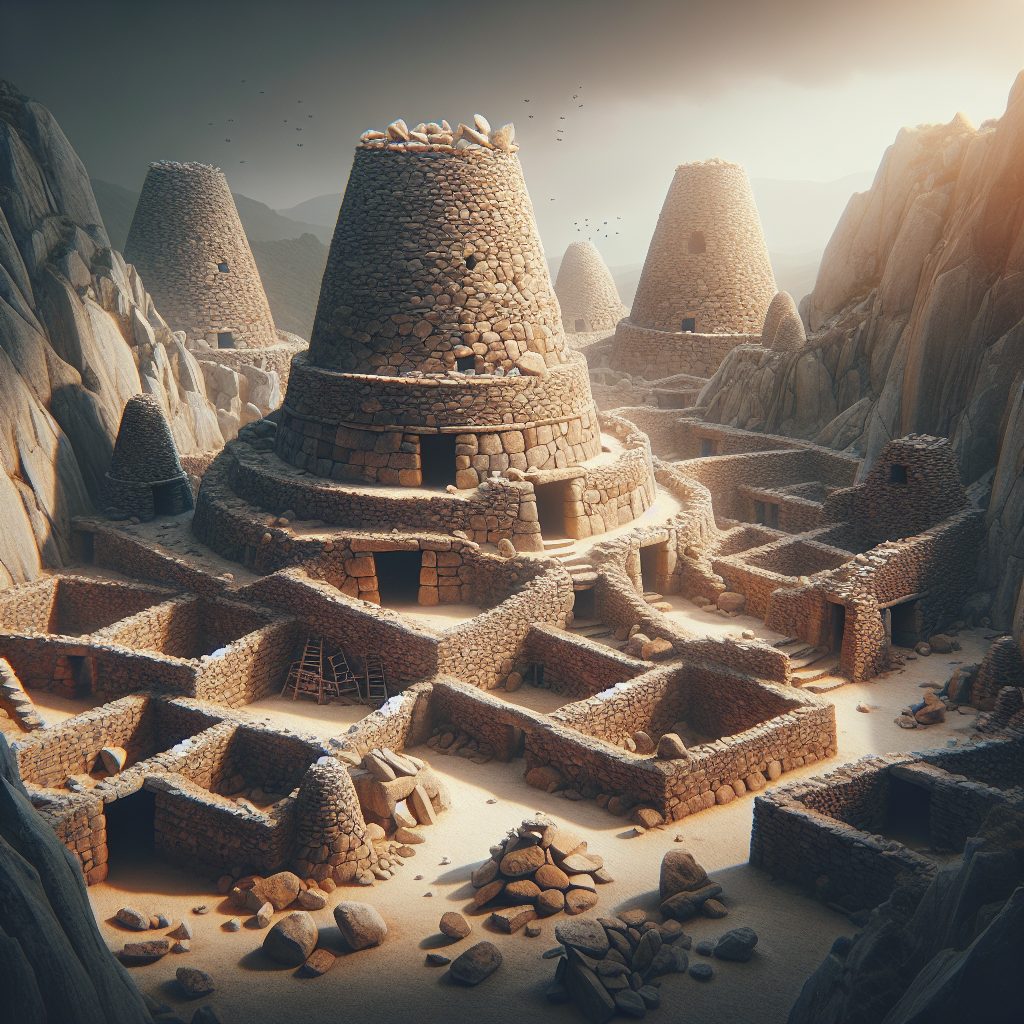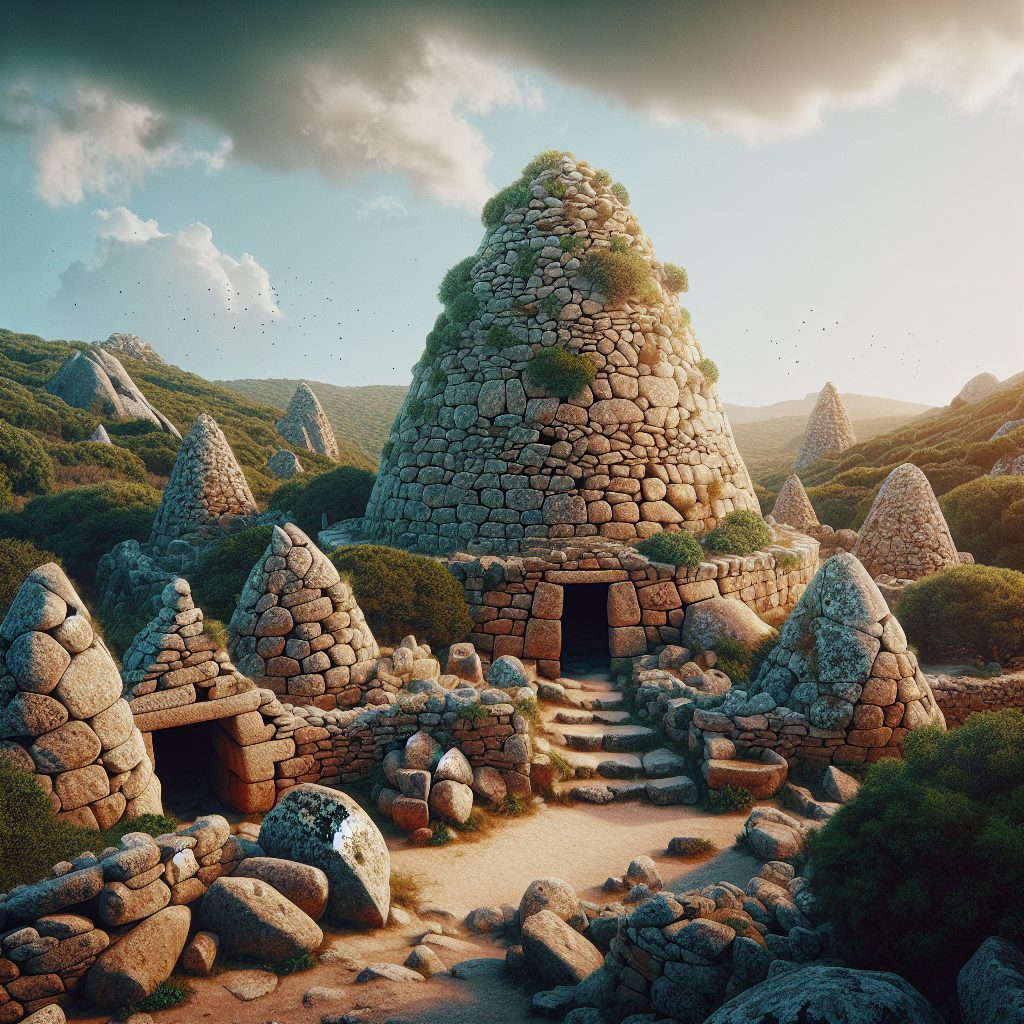Nuraghe, a term derived from the Sardinian word for “heaps of stones,” refers to a unique type of ancient megalithic structure found exclusively in Sardinia, Italy. These remarkable structures serve as a testament to the sophisticated architectural skills possessed by the Nuragic civilization that once thrived on the island. The Nuraghe abounds with fascinating historical and cultural significance, making it a well-deserved UNESCO World Heritage site.
Nuraghe structures are characterized by their colossal size, often towering over the Sardinian landscape as fortresses of the past. Built using the “dry stone” technique, these magnificent edifices were constructed using only stones, defying gravity to form intricate and strategic designs. The interior of these structures presents a honeycomb-like maze of interconnected chambers, showing the advanced engineering capabilities of the Nuragic people. These massive stone structures, which date back to the Bronze Age, have sparked the curiosity of archaeologists and history enthusiasts alike, providing invaluable insights into the ancient civilization that once inhabited this enchanting island.
Now that we have explored the captivating origins and unique features of the Nuraghe, let us delve into the key takeaways that will unravel the enthralling history and mysteries of this UNESCO World Heritage site. In the following sections, we will delve into the historical background of the Nuragic civilization and their fascinating way of life, explore the various types of Nuraghe structures and their significance, and shed light on the ongoing efforts to preserve and protect these remarkable architectural marvels for future generations to appreciate and discover. So, join us on this journey as we uncover the secrets of the Nuraghe, an awe-inspiring testament to the ancient past of Sardinia.
Key Takeaways
1. Nuraghe, a unique historical monument found only in Sardinia, Italy, has been recognized as a UNESCO World Heritage site due to its remarkable stone tower structures and complex architectural design.
2. The Nuraghe are ancient stone structures dating back to the Bronze Age, which served as fortified dwellings for the Nuragic civilization that flourished on the island from 1800 to 500 BC, providing valuable insight into a long-lost civilization’s culture and lifestyle.
3. These fascinating structures, built using massive stones and displaying advanced engineering techniques, vary in size and layout, with the central tower often being surrounded by additional smaller towers, courtyards, and chambers that were used for residential and ceremonial purposes.
4. The Nuraghe have sparked great interest among archaeologists and researchers due to their mysterious origins and purpose. Although their exact function is still not fully understood, it is believed that they served as defensive fortresses, religious centers, or status symbols for the rulers of the Nuragic society.
5. The inclusion of Nuraghe in the UNESCO World Heritage list not only preserves these remarkable historical structures for future generations but also promotes the importance of understanding and appreciating the diversity and significance of human cultural heritage.
What is Nuraghe UNESCO Heritage and Its Significance?
Nuraghe UNESCO Heritage refers to the ancient megalithic structures found in Sardinia, Italy. These unique archaeological remnants hold great historical and cultural value and have been recognized by UNESCO as a World Heritage Site. Let’s explore the significance of Nuraghe and dive into its intriguing features.
The History and Origins of Nuraghe
Nuraghe structures date back to the Bronze Age, between 1900 and 730 BCE. They were built by the Nuragic civilization, which thrived on the island of Sardinia during this period. These impressive stone towers, constructed without mortar, served various purposes, including defensive, social, and religious functions.
The exact purpose of Nuraghe has been a topic of debate among archaeologists. Some believe they were defensive structures, offering protection against invaders. Others suggest they were symbols of social status. Additionally, the unique architecture and advanced building techniques used in constructing Nuraghe reflect the cultural and technological advancements of the Nuragic people.
The Features of Nuraghe
Nuraghe structures are characterized by their impressive design and construction. The main tower stands out as the focal point, surrounded by secondary towers and walls. The main tower usually consists of superimposed layers, with internal staircases leading to upper chambers.
The walls of Nuraghe are made of large blocks of stone, stacked without the use of mortar. This meticulous construction technique showcases the architectural skills of the Nuragic civilization. Some Nuraghe complexes also include additional structures, such as courtyards, huts, and wells, providing insights into the daily lives of the ancient inhabitants.
Understanding the Significance of Nuraghe
Nuraghe UNESCO Heritage holds immense historical, cultural, and archaeological significance. These structures provide invaluable insights into the Bronze Age civilization, offering glimpses into the religious practices, social hierarchies, and defense mechanisms of the ancient Nuragic people.
By exploring Nuraghe sites, researchers and visitors have the opportunity to delve into the past, unraveling the mysteries of the Nuragic era. The UNESCO recognition ensures the preservation and protection of these sites, enabling future generations to appreciate and understand the rich history of Sardinia.
Exploring Nuraghe Today
Visiting Nuraghe sites today allows tourists and history enthusiasts to witness the magnificence of these ancient structures firsthand. Numerous sites across Sardinia, such as Barumini, Su Nuraxi, and Palmavera, offer guided tours and educational experiences.
By exploring the interior of the towers and admiring the intricate stonework, visitors can gain a deeper understanding of the life and culture of the Nuragic people. Additionally, the panoramic views from the top of the towers provide a breathtaking glimpse of the surrounding landscapes.
Useful Tips for Exploring Nuraghe
- Plan your visit during the cooler months to avoid the heat and crowds.
- Wear comfortable shoes as some sites require walking over uneven terrain.
- Book a guided tour to enhance your understanding of Nuraghe and its history.
- Bring a camera to capture the stunning architectural details and landscapes.
- Respect the sites by following any rules or regulations implemented for their preservation.
Frequently Asked QuestionsWhat is Nuraghe UNESCO Heritage?
What is Nuraghe UNESCO Heritage?
Nuraghe UNESCO Heritage refers to a collection of ancient stone structures found in Sardinia, Italy. These structures, commonly known as nuraghe, were built during the Nuragic civilization, which flourished on the island between the 18th and 6th centuries BC. The UNESCO Heritage designation recognizes the cultural and historical significance of these architectural marvels.
How many nuraghe sites are there in Sardinia?
Sardinia is home to over 7,000 nuraghe sites, making it an unparalleled treasure trove of ancient architecture. These sites vary in size and complexity, ranging from small, single-towered nuraghe to large, multi-towered complexes. Each site offers a unique glimpse into the ancient Nuragic civilization and its impressive engineering skills.
What was the purpose of nuraghe?
The exact purpose of nuraghe is still a matter of debate among archaeologists and historians. However, they are generally believed to have served as defensive structures, religious centers, or symbols of power and wealth. The construction and strategic location of these nuraghe suggest that they played a crucial role in the social and political life of the Nuragic civilization.
How were nuraghe built?
Nuraghe were constructed using large blocks of basalt or limestone, which were carefully stacked without the use of mortar. The structures were typically built in a conical or tower-like shape, with multiple floors connected by internal staircases. The sophisticated design and construction techniques of nuraghe continue to awe modern architects and engineers.
What can visitors expect to see at nuraghe sites?
Visitors to nuraghe sites can explore the remnants of these ancient structures, including their impressive stone walls, chambers, and corridors. Some larger nuraghe even feature reconstructed roofs, offering a better understanding of their original form. Additionally, many sites have informative displays, exhibitions, and guided tours that provide insights into the Nuragic civilization and its rich cultural heritage.
Are nuraghe sites accessible to all visitors?
While some nuraghe sites are easily accessible, others may require a certain level of physical fitness and mobility due to their remote locations or uneven terrain. It is advisable to check the accessibility of specific nuraghe sites before planning a visit. However, efforts are being made to improve accessibility and provide a more inclusive experience for all visitors.
Can visitors climb the nuraghe structures?
For safety and preservation reasons, climbing nuraghe structures is generally not permitted. These ancient structures are delicate and can be damaged by excessive weight or inappropriate handling. However, visitors can still get a close-up view of the structures and appreciate their architectural brilliance from ground level.
Is photography allowed at nuraghe sites?
Yes, photography is typically allowed at nuraghe sites. Capturing the beauty and grandeur of these ancient structures is a memorable way to preserve the experience and share it with others. However, it is important to respect any restrictions or guidelines regarding photography, especially if visiting privately owned or protected nuraghe sites.
Are there any visitor facilities at nuraghe sites?
Nuraghe sites often provide visitor facilities such as parking areas, information boards, restrooms, and sometimes even snack bars or souvenir shops. These amenities aim to enhance the visitor experience and ensure a comfortable visit to these remarkable historic sites. It is advisable to check the specific facilities available at each nuraghe site before arrival.
Can I take guided tours at nuraghe sites?
Yes, many nuraghe sites offer guided tours led by knowledgeable guides. These tours provide valuable insights into the history, architecture, and significance of the nuraghe structures. Guided tours are an excellent way to fully appreciate the cultural and historical context of these ancient wonders.
Final Thoughts
The Nuraghe UNESCO Heritage sites in Sardinia are truly remarkable testaments to the ingenuity and craftsmanship of the ancient Nuragic civilization. Exploring these ancient stone structures is like stepping back in time, allowing us to appreciate the rich cultural and historical legacy of Sardinia. Whether you’re an archaeology enthusiast, history lover, or simply curious about the mysteries of the past, a visit to the nuraghe sites is an unforgettable experience that will leave you in awe of the human capacity for creativity and innovation.
As we marvel at the nuraghe sites, we also acknowledge the importance of preserving and protecting these precious cultural treasures. By respecting the rules and guidelines set forth by authorities, we can ensure the safeguarding of these ancient structures for future generations to cherish and learn from. Let us celebrate the Nuraghe UNESCO Heritage and continue to explore and appreciate the wonders of human history.






